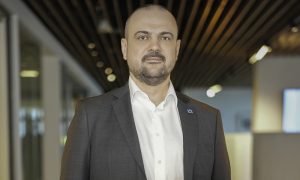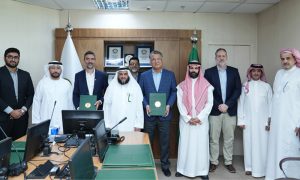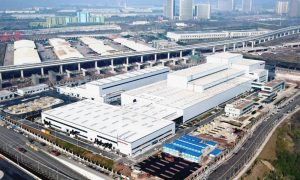Raising the game: Tower crane specialist Raimondi
Now under GCC-based KBW Holdings’ ownership, the Italian brand is looking to build on its long history of innovation and quality

Founded during the initial years of industrialisation in Italy in the 1800s, Raimondi Cranes is the quintessential Italian company, marrying the country’s tradition of local ingenuity, design and craftsmanship with modernity and cutting-edge technology.
In 1863 Rodolfo Raimondi saw the opportunity to produce the first transmission equipment used in a cotton mill in Legnano, a city where, until today, Raimondi’s operative headquarters are located. In the following century, particularly after World War II, Raimondi devoted itself to helping rebuild its own country through the manufacture of construction equipment from concrete mixers to tower cranes. And since 1946, Raimondi has devoted all its resources for the production of tower cranes, which gradually took the company beyond its national frontiers.
The reach of Raimondi and its global fame was confirmed in 2014 when KBW Investments purchased the company. The holding company, owned by Saudi Arabia’s Prince Khaled bin Al Waleed bin Talal, found merit in the Italian tower crane specialist, which enjoys a great brand image globally.

Raimondi’s new chairman after the KBW acquisition, Ahmed Alkhoshaibi, tells CMME that the purchase of the crane maker was a carefully thought-out decision.
“Prince Khaled and I had met a few years prior, and we had discussed going into business together. With Raimondi, the timing was right – there was a huge market opportunity there and we jumped on it. I make it sound like a quick decision, but it obviously wasn’t as it involved a fairly intensive due diligence evaluation followed by the acquisition process,” Alkhoshaibi says.
“When we announced it in January 2014, it was basically the first step in what is now KBW Investments. To sum up its significance, when Prince Khaled expressed interest in the construction sector, he knew that the opportunity to enter the industry with an establishment like Raimondi Cranes happens very rarely. As a heritage manufacturer that has existed for a century and a half, we consider it a pillar in the KBW portfolio and an anchor of sorts. Becoming part of a group that holds an esteemed and lasting brand is a real source of pride to our other enterprises.”
The acquisition did not come without its challenges, however, and Alkhoshaibi continues: “First off, there is always a warming-up period when new business relationships are formed in any scenario – be it a partnership, a JV, a one-off test job. Now, when you’re commencing an acquisition, during that first assessment and action period, it needs to be handled delicately.
Respect for the brand
“I think it was important to convey how much we respected the brand and understood its deep roots. Raimondi’s team knew that we weren’t coming in there with an attitude that suggested we were ignorant of the ownership and fealty that they all felt towards its welfare as an Italian brand. In Legnano’s once-strong manufacturing history, Raimondi acts as almost a beacon of hope. It was an area known for world-class production, everything from cotton to the manufacture of sophisticated equipment.”
The feelings of ownership and fealty that Alkhoshaibi speaks of come from being part of a brand that has withstood the test of time for more than century and has become like family to its employees and to the community in its home city. Every person employed by Raimondi Cranes is dedicated to the brand on a personal level, he adds.
“You almost never see this level of loyalty and staff engagement in today’s corporate world. They all feel as though they have a personal stake in the company’s success and it’s a truly valuable aspect,” Alkhoshaibi explains.
“One of the things Raimondi’s executive team is tasked with is retaining our long-term staff members. These are people who have worked at the manufacturer for more than 10 or 20 years, and who literally know every detail of every crane. That type of knowledge-equipped human capital who have an inherent familiarity with our products cannot be recruited or trained in a year or two, or even three. One of the main Raimondi directives is to retain these brand experts and utilise this unparalleled advantage that it gives the company, technically speaking.”
Acquiring Raimondi and pushing the company to the next level meant that changes had to be made, however, but the essential point was how those changes were brought about.
“Prince Khaled made several visits personally, getting to know the executives and the people who had been with the company the longest, and I spent a considerable amount of time there in those early days. This, too, makes a difference during an acquisition.”

Alkhoshaibi adds that Prince Khaled likes to describe the KBW Investments evolution in the context of pre and post Raimondi Cranes acquisition. The Raimondi acquisition created the foundation of what is now a comprehensive portfolio that is at work on some of the region’s most ambitious projects.
“In the UAE, KBW group company, NGP, signed a PPP with Dubai Courts, and in Jordan, we signed two for nationwide LED adoption, a factory, and a solar PV plant. Raimondi is an integral part of the KBW Investments Group portfolio – it is a cornerstone, and by sheer dint of being a pervasive global manufacturer in the heavy machinery segment, it gives KBW a unique vantage point. I have to say that Raimondi has seen tremendous benefits, and in turn, KBW Investments too, has seen leaps forward as the parent company.”
When the acquisition was announced in 2014, KBW had simultaneously revealed that it would invest around $100 million in Raimondi over a three-year time period. A fairly significant percentage of that sum was allocated to research and development, Alkhoshaibi adds.
“Raimondi’s latest products, conceptualised fully in-house, indicate the direction the company has gone in since the acquisition. With more resources, the company had the ability to recruit more talent and no longer felt suffocated by time constraints, thereby allowing the technical team to comfortably experiment with fresh technological alternatives.
“The inventive application of research and the resulting solution-based designs of our three latest launches were rewarded by solid sales numbers. The technical segment, headed by technical director Domenico Ciano, is encouraged to be imaginative and the results of this has been nothing short of fantastic for the brand and for company morale,” Alkhoshaibi says.
A percentage of that amount is also currently invested in enhancing existing production capabilities and being used to upgrade capacity. The chairman adds that Raimondi is currently in the process of acquiring a new factory that is approximately five times the size of its current headquarters. The new facilities will allow it to ramp up production and meet growing demand.
Middle East focus
During KBW’s acquisition of Raimondi, there was also talk of expanding manufacturing to other geographies – especially to Saudi Arabia, Brazil and India. Alkhoshaibi points out, however, that after polling its Middle Eastern clients, Raimondi found that in lieu of production bases, what was needed and requested were twofold: full scale facilities including offices, and yards staffed with specialised, trained personnel.
“Instead of the manufacturing side, we invested that capital in setting up full-scale operations in the GCC. We employ over 150 people in Saudi Arabia, UAE, and Qatar. Raimondi in the Middle East is a client-direct model, meaning that it is the same as dealing directly with the manufacturer in Italy. There is a local service department, sales department, and technical team,” Alkhoshaibi explains.
With Brazil in the grip of an economic slowdown, which has affected its construction sector as well, plans of expansion there have been put on hold. However, India is another story. “We are proceeding (with expansion plans) in India and making good progress on that front. We haven’t officially announced this as yet, but we are optimistic about our plans to be up and running in late Q1 or early Q2 2017.”
KBW’s understanding of and focus on the Middle East has started paying off for Raimondi with significant sales this year, as Alkhoshaibi reveals: “During Q1 and Q2, 35 cranes were sold in the Middle East. Rounding of the year, we’re forecasting 60 cranes – with the bulk of these heading to Qatar and Saudi Arabia. Currently in Algeria, there are eight Raimondi MRT294s installed as part of a large scale project.”
But the Middle East is not the only market to hold positives for Raimondi; there is good news from other parts of the globe as well, especially from down under, Alkhoshaibi reveals.
“Raimondi is doing absolutely knock-out numbers in Australia. In 2015, the most Raimondi cranes were sold to Australia, and it has a lot to do with the strength of the construction sector there, combined with the constant business development activities of our agents, Strictly Cranes and Clark Cranes, who are both positioning Raimondi on commercial and residential sites nationwide. Currently, there are more than 200 Raimondi cranes erected in Australia, and an additional crane is being erected in a Sydney suburb,” he says.
With these results and with its understanding of the Middle East market, Alkhoshaibi is unperturbed by the slowdown that the region is experiencing currently. With KBW already heavily engaged in several large-scale projects, which may also use Raimondi cranes, he trusts the economies of scale that come with being part of a large group – as well as the opportunity to leverage the group’s collective strength to benefit individual entities such as a Raimondi.
“We make it a point that our companies, as much as possible, try to cross-collaborate on large and small projects. A particular project might require interior fit-out, engineering, BIM-modelling, post tensioning, so on and so forth. KBW has the capability to execute turn-key projects so we encourage our companies to look internally before considering external alternatives. It’s one of the benefits of having a parent company, and it really can make a significant difference in sustaining an enterprise during a market lull,” Alkhoshaibi says.
Specifically, in Raimondi’s case, he adds, the challenges are mitigated due to a global footprint because when one area is facing a slower market, other areas may be picking up. “In Turkey, for example, we have maintained an average of selling at least 40 cranes per year over the past eight years. That’s a solid market for Raimondi, despite the challenges the country might be facing.”
But long-term success is not about the size and importance of the parent group or about supportive market conditions. A company needs to stand on its own with a sustained commitment to quality and innovation, and set itself apart from the competition by offering something extra, as Raimondi has done.
“Each and every Raimondi crane is a fully-European manufactured heavy machine. A contractor putting a Raimondi crane to work on a jobsite has confidence in the product because there is a solid material and technology sourcing line – every component is traceable back to Italy,” Alkhoshaibi points out.
“Secondly, a Raimondi crane is heavy equipment that the construction sector can rely on. On our technical team, the engineers often joke that some of the queries they field are about cranes older than them. This is end user-generated testimonial to the durability and longevity of Raimondi cranes; these machines are lasting and worthwhile investments.
“Third, the Raimondi Cranes agent network is agile and active globally, also indicating confidence in the product and faith in a trusted heritage brand. Two of our European agents – Irish Cranes & Lifting and Bennetts Cranes – recently made news as top-ten tower crane companies in the United Kingdom. Both these agents have positioned Raimondi’s cranes on news-making jobsites, and both showcase Raimondi’s cranes in their fleets. The fact that we take the relationship with our agents to another level does set us apart, as we believe the best feedback comes from the ground.”
Alkhoshaibi adds that Raimondi meets frequently with its agents, collects feedback and opinions, and backs it up with a quick turnaround time of implementation.
“For valued customers we also operate on a bespoke level – we adapt quickly and ensure that client needs and specifications are adhered to and addressed whenever possible,” he says.
And that is a winning mantra.
——————————————————————-
New LR213 luffing crane: Scaling upwards
Raimondi’s latest offering is the new LR213 luffing crane, which is available with five different jib length configurations, from 28m to 55m.
The maximum lifting capacity of the crane is 14t, which is reachable on all jib lengths, while the max tip load with the 55m meter jib configuration is 2.25t. The LR213 id powered by a 100hp winch with a 1000m rope capacity. This allows a reach of 500m with two-fall configuration and 250m with four-fall one.
As an added benefit, this winch can be equipped with a secondary emergency brake too, standard for the luffing winch. All the mechanisms and the electronic components are positioned on the counter jib platform for safe and easy installation, and convenient maintenance. Only one electrical cabinet, installed on the cabin platform, allows for swift installation and cable connection.
“Our engineers worked hard on the control system to ensure improved performance and enhanced safety,” says Alkhoshaibi. “Both the motor and the inverter are optimised to give the operator increased speed paired with more movement control, resulting in a more productive jobsite.”
These features also allow for precision in load positioning, thereby reducing operator stressors, and the new control system makes commissioning easier and quicker. With a simple choice of jib length and working height, the system is ready to receive all the information during the test load phase for crane calibration, he adds.
———————————————————————-
New Deluxe R16 cabin: Control in the air
Raimondi’s newest design development is the Deluxe R16 cabin, an ergonomically designed command centre for crane operators created by the Italians’ R&D arm based on customer and operator feedback and trials.
With more than 80% of its total surface made of glass, the cabin enhances visibility for operators and offers full jobsite views. Thermal and acoustic insulation has been given special attention, while simultaneously reducing glare and reflection. Together with Raimondi’s supplier, special two-toned windshield glass was developed, ensuring interior cabin comfort while maintaining the visibility.
The new Deluxe cabin is equipped with the new control system V3.0 human-machine interface, which allows operators to check the full parameters during work clearly and easily. It also allows the maintenance team to check and set the crane quickly. A fully integrated system, the R16 is equipped with anemometer, black box, radius, load and wind indicators, and a zoning option can be added.
One of the largest cabins available today, the cabin measures 2.07m in height, 2.135m in length and 1.40m in width. Ergonomic seating with mobility upwards, downwards, forwards and backwards enables operators to find their best positions for optimal control. The new operator panel, with enhanced arrangement of commands and controls also help to optimise performance and ease of use.
To increase durability and longevity, the cabin has been built with increased stiffness, which facilitates cabling during assembly or maintenance, and cabling wear and tear prevention during storage.
























